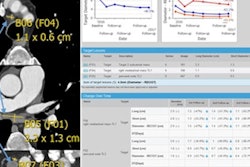
At institutions that have clinical decision support (CDS) for radiology orders, not many imaging studies deemed to have low appropriateness are performed. Sometimes these exams may be justifiable, however, according to research published online February 9 in the Journal of the American College of Radiology.
In a retrospective analysis of more than 400,000 outpatient imaging orders over a five-year period at Massachusetts General Hospital (MGH), researchers found that fewer than 3% were given a low clinical appropriateness score by the institution's CDS software. Nearly two-thirds of these were still eventually performed, with the most common indication being a request by a physician specialist based on his or her opinion of medical necessity, according to the team led by Dr. Supriya Gupta, now at the Medical College of Georgia in Augusta, GA.
"The implementation of a decision-support-enabled order-entry system can provide useful guidelines for physicians for placing the most appropriate imaging order; however, it needs to accommodate the relatively few cases where physician insight or other clinical information merits performing an apparently low-appropriate-score exam," the authors wrote.
The group also specifically analyzed the outcomes of a subset of these imaging studies that had been requested by patients, concluding that a relatively substantial number of these cases had clinically significant findings.
Ordering rationale
MGH implemented clinical decision support for its radiology order-entry system in 2004. Clinical appropriateness scores based on the American College of Radiology Appropriateness Criteria provide real-time and color-coded feedback to ordering clinicians on their requested exam:
- Scores of 1-3 signify low-yield exams and are coded in red.
- Scores of 4-6 are considered to have marginal yield and are coded in yellow.
- Scores of 7-9 are deemed too have high yield and are coded in green.
The order can still be completed if the system returns a low-yield score (≤ 3), but the software asks clinicians for an explanation.
Hypothesizing that very few outpatient imaging exams with a low clinical appropriateness score would be ordered and performed now that the CDS system had been in use for several years, the researchers sought to delve into those cases that proceeded with the original order despite a low score. Gupta and colleagues queried their radiology order-entry system for all outpatient orders from January 2007 to December 2011 and selected all orders with a low decision-support score (0-3).
They then analyzed these exams based on factors such as patient demographics, reasons for the order, and report characteristics. They also recorded and analyzed the explanations provided by the ordering physician for continuing with the exam order despite the low clinical appropriateness score. Next, the researchers specifically evaluated the outcomes for all of these exams that had been performed due to patient demands.
Of the 445,984 outpatient imaging exams ordered over the five-year period, 12,615 (2.8%) were given a clinical appropriateness score of less than 3 and 7,956 (63%) were still performed despite the low score. A request by a physician specialist without any further explanation was the most common reason for ordering exams with low appropriateness scores.
| Reasons for ordering imaging studies with low appropriateness scores | |
| Requests by physician specialists without further explanation | 4,516 (35.8%) |
| Notation of special clinical circumstances | 2,877 (22.8%) |
| Requests by nonphysician staff without further explanation | 1,383 (10.9%) |
| Absence of suspected finding on previous modality | 1,099 (8.7%) |
| Patient demand | 737 (5.8%) |
| Radiologist's recommendations | 706 (5.6%) |
Special clinical circumstances
As for those imaging orders that were initially given a low clinical appropriateness score but were still performed, "special clinical circumstances" was the indication that produced the highest percentage of studies.
| Reasons why low-scoring original orders were still performed | |||||
| Special clinical circumstances | 85% of original orders were performed | ||||
| An exam with a higher clinical appropriateness score would take more time to perform | 74.7% of original orders were performed | ||||
| Previously indicated modality did not reveal a finding | 71.3% of original orders were performed | ||||
| Patient demand | 67.8% of original orders were performed | ||||
| Primary care physician request | 66% of original orders were performed | ||||
| Radiologist's recommendations | 51% of original orders were performed | ||||
"It should be noted that the most common indication for ordering a low-appropriateness-score exam was a request placed by a specialist, whereas the most common justification for performing such an exam was its clinical relevance," the authors wrote.
Patient requests
For the imaging exams ordered due to patient demands, the researchers found clinically significant imaging outcomes in 20.3% of exams for male patients and in 16.9% of exams for female patients. The highest percentage of clinically significant imaging outcomes occurred in extremity MR studies.
| Clinically significant outcomes for exams ordered due to patient demands | |||||
| Extremity MRI | 66.7% of exams | ||||
| Face/sinus CT | 27.3% of exams | ||||
| Head/brain CT/MRI | 20.8% of exams | ||||
| Cardiac CT or stress testing | 14.6% of exams | ||||
| Spine CT or MRI | 10.5% of exams | ||||
| Abdominal aortic aneurysm screening | 4% of exams | ||||
In other findings, 60% of patient-demanded imaging exams came from female patients, while 40% were generated by male patients. This difference was statistically significant (p < 0.01).
Limitations?
The relatively substantial number of cases with clinically significant findings suggests that perhaps the appropriateness system has limitations and some aspects should be re-evaluated, according to the group.
"Alternatively, the findings, although positive, might not affect outcome or might have been detected by a more appropriate study as well," the authors wrote.
The researchers also pointed out that their system has been further updated since the time frame of the study. At the time, it may not have included all of the clinical signs and symptoms that are now recognized to be significant.
The authors noted that a request placed by a specialist for an exam that is given a low score by the CDS system may stem from clinical intuition or unique patient medical conditions not addressed by the system, but which could justify ordering a low-score exam.
"Logically, it will never be possible to write down a rule to cover every possibility, and pre-empting the ability of physicians to override the rules when they feel it imperative would negate the value of their special knowledge of their patients," the authors wrote.
The justifications for performing low-appropriateness exams should be tracked and analyzed, both to help educate providers and to see if appropriateness criteria should be modified, according to the group.
"Education about the trend of ordering and ultimately performing low-utility-score exams can provide recommendations for revising decision-support systems and enable a better understanding of imaging utilization in a given setting," the authors wrote.




















